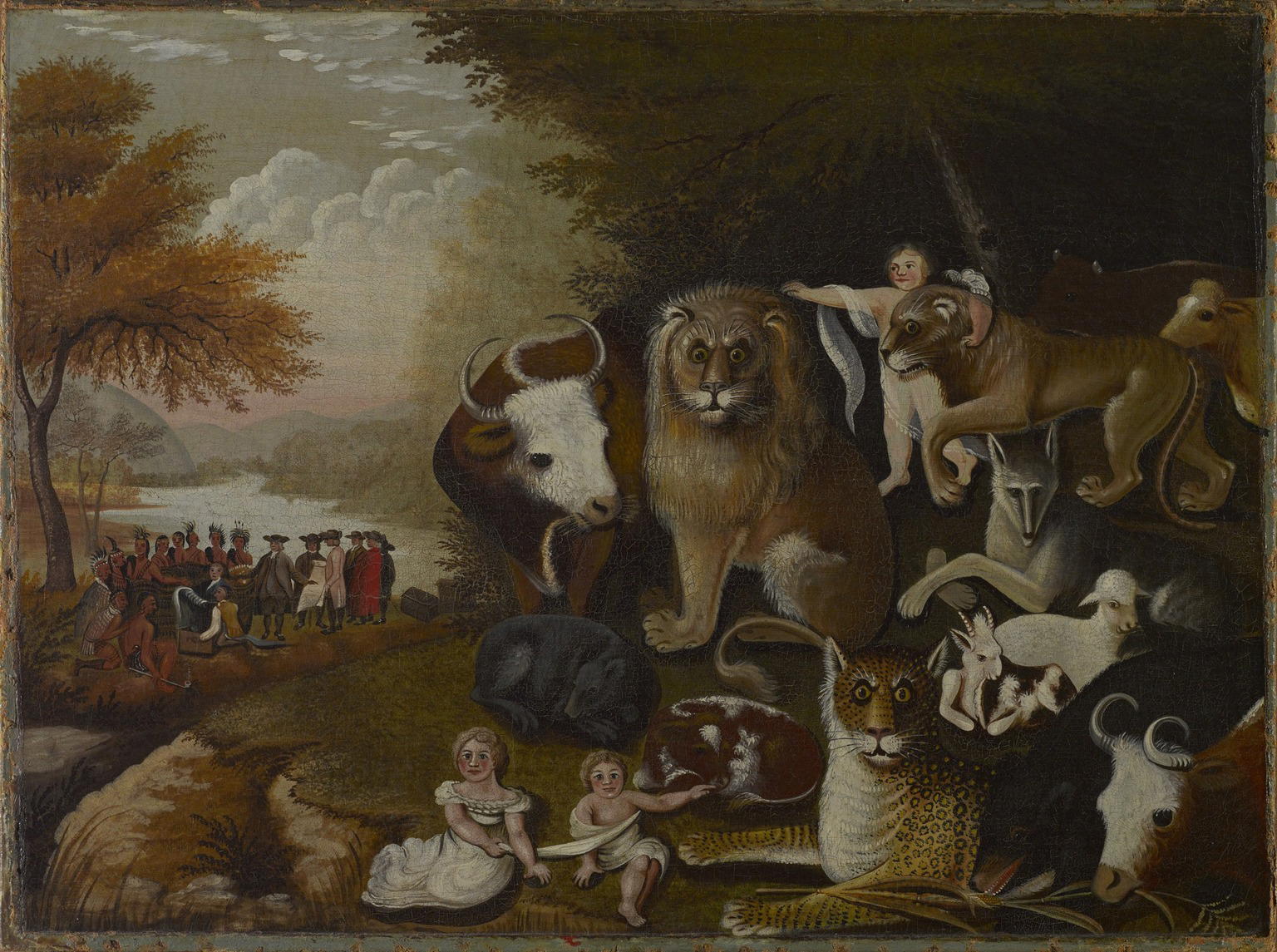The Peaceable Kingdom

Brooklyn Museum photograph
Object Label
In this Edenic scene inspired by a passage from the Book of Isaiah, Edward Hicks visualized the peaceful coexistence of God’s creatures, depicting animals and children in the right foreground along with a vignette in the background of William Penn’s treaty with the Lenape. Hicks idealized the encounter between British colonists and Indigenous people, creating fictions of harmony. Ultimately, the Lenape were forced out of Pennsylvania owing to fraudulent land deals perpetrated by Penn’s sons.
Caption
Edward Hicks (American, 1780–1849). The Peaceable Kingdom, ca. 1833–1834. Oil on canvas, 17 7/16 x 23 9/16 in. (44.3 x 59.8 cm) frame: 23 1/4 x 29 1/4 x 1 3/8 in. (59.1 x 74.3 x 3.5 cm). Brooklyn Museum, Dick S. Ramsay Fund, 40.340. (Photo: Brooklyn Museum)
Gallery
Not on view
Collection
Gallery
Not on view
Collection
Artist
Title
The Peaceable Kingdom
Date
ca. 1833–1834
Medium
Oil on canvas
Classification
Dimensions
17 7/16 x 23 9/16 in. (44.3 x 59.8 cm) frame: 23 1/4 x 29 1/4 x 1 3/8 in. (59.1 x 74.3 x 3.5 cm)
Signatures
Unsigned
Credit Line
Dick S. Ramsay Fund
Accession Number
40.340
Frequent Art Questions
I am curious about William Penn in the background. Why did Hicks include that scene with the animals in the foreground?
That's an excellent question! The story of William Penn and his treaty with Native Americans in present-day Philadelphia coincides with the story of the animals because both represent the hope of peace and unity between different groups.The background scene is actually based on a famous painting by the artist Benjamin West, titled "Penn's Treaty with the Indians."So interesting!! Thank you. Last question, is Penn the man standing or kneeling?He is the standing man gesturing with his arms. He's surrounded by other Quakers, Swedish settles, and Native Americans (specifically, Lenni Lenape).An interesting fact: Hicks would have known this painting from a printed reproduction, and the original composition was flipped in the printing process -- so Hicks's scene of Penn's treaty is the reverse of the original!Why is this painting freaking me out so much?!
 You tell me! What are some things that you notice that strike you as odd?Umm I think it's the eyes.The eyes are pretty odd. The artist Edward Hicks was a self taught painter, so this work falls into the realm of 'folk art'. The artist doesn't seem to be painting from observation, so perhaps thats why things seem so freaky?Self taught, interesting, would this also be considered primitive art? If not, what is the difference?Well 'primitive art' or 'naive art' are terms most artists and museums try to avoid now, as they have negative connections.But to contrast the two, I suppose that you could say 'primitive art' is work made outside of the history of western art. For example, the work of native peoples, Australian, African and non-western cultures. Where as 'naive' or 'outsider' art is made within the lineage of western art but the artists don't have a formal education from an art school, academy, or guild. Folk artists simply teach themselves techniques and strategies for how to make art. I hope that answered your question!It did, thank you.
You tell me! What are some things that you notice that strike you as odd?Umm I think it's the eyes.The eyes are pretty odd. The artist Edward Hicks was a self taught painter, so this work falls into the realm of 'folk art'. The artist doesn't seem to be painting from observation, so perhaps thats why things seem so freaky?Self taught, interesting, would this also be considered primitive art? If not, what is the difference?Well 'primitive art' or 'naive art' are terms most artists and museums try to avoid now, as they have negative connections.But to contrast the two, I suppose that you could say 'primitive art' is work made outside of the history of western art. For example, the work of native peoples, Australian, African and non-western cultures. Where as 'naive' or 'outsider' art is made within the lineage of western art but the artists don't have a formal education from an art school, academy, or guild. Folk artists simply teach themselves techniques and strategies for how to make art. I hope that answered your question!It did, thank you.Is this "The Peaceable Kingdom" the only one that exists? I thought I had seen it before elsewhere but bigger?
You're right! This isn't the only version of Edward Hicks 'The Peaceable Kingdom'. From about 1820, the self-taught artist and Quaker preacher Edward Hicks painted approximately sixty versions of 'The Peaceable Kingdom'. The other versions are scattered at many different institutions across the nation. So you very well have seen a larger one.Hello! Why did Edward Hicks portray animals in such a humanlike way?
 Great observation. It is a concept known as anthropomorphism. It is when you give animals human characteristics. This is also indicative of a certain Folk quality in Hicks' art. You may even compare him to Rousseau, who painted exotic creatures and locations with the magical naiveté of a child.
Great observation. It is a concept known as anthropomorphism. It is when you give animals human characteristics. This is also indicative of a certain Folk quality in Hicks' art. You may even compare him to Rousseau, who painted exotic creatures and locations with the magical naiveté of a child.
Have information?
Have information about an artwork? Contact us at